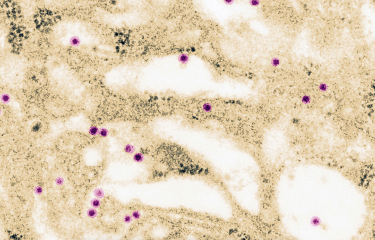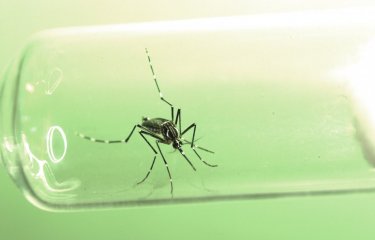Scientists at the Institut Pasteur in Cambodia, the Institut Pasteur in Paris and the CNRS provided proof that people infected by dengue virus but showing no clinical symptoms can actually infect mosquitoes that bite them. It appears that these asymptomatic people – who, together with mildly symptomatic patients, represent three-quarters of all dengue infections – could be involved in the transmission chain of the virus. These findings, published in the journal PNAS, on the 9 of November, question established theories concerning the epidemiology of dengue.

A mobile team nurse from the Epidemiology and Public Health Unit at the Institut Pasteur in Cambodia working in the field. © Arnaud Tarantola – Institut Pasteur in Cambodia
Dengue virus infects 390 million people worldwide each year through the bite of mosquitoes of the Aedes genus. But estimates suggest that 300 million of these people do not present clinical symptoms that are severe enough to be detected by health care systems.[1] It was previously thought that these asymptomatic or mildly symptomatic infections did not reach a high enough level of viremia (the concentration of the virus in the blood) to infect mosquitoes.
In this study published in PNAS, scientists from the Institut Pasteur in Cambodia, the Institut Pasteur in Paris, and the CNRS focused their attention on the hidden mass of the iceberg, in other words the people with few or no symptoms that represent 75% of all dengue infections, and experimentally tested whether these people could actually contaminate mosquitoes. The scientists carried out their study in a human population at risk of dengue infection in Cambodia, in the town of Kampong Cham, roughly 100km northeast of Phnom Penh. Their research strategy relied on their ability to detect dengue infections that had not been identified by traditional health care systems because the participants showed virtually no signs of the disease.
The scientists performed blood tests on people living in close proximity – in the same household or in the immediate neighborhood – to patients with confirmed symptomatic dengue. People who tested positive for dengue virus in their blood tests but without clinical symptoms were then put into contact with healthy laboratory-bred mosquitoes. Subsequent analysis of the mosquitoes confirmed they had been infected and would be capable of transmitting the virus the next time they bit a human. The research data also confirmed that the viremia level is a critical factor in transmission of dengue virus from a human to a mosquito.
"This finding raises the possibility that people with few or no symptoms – in other words the majority of those infected by dengue – may actually be contributing to the spread of the virus without realizing it," explained Louis Lambrechts, a CNRS scientist in charge of the Insect-Virus Interactions Group at the Institut Pasteur in Paris. Moreover, people who are virtually or completely unaffected by the virus are potentially exposed to more mosquitoes during their daily routines than those who are severely ill, bed-ridden or hospitalized.
"These data should lead us to revisit our approach to the early management of dengue epidemics. Transmission rate estimates will also have to be adjusted to ensure sufficient vaccination coverage for the vaccines currently under development," commented Veasna Duong, a scientist in the Virology Unit directed by Philippe Buchy at the Institut Pasteur in Cambodia, when this work had been done. Meanwhile, at the Institut Pasteur in Paris, the DENFREE European project, coordinated by Anavaj Sakuntabhai, is investigating the specific biological characteristics of asymptomatic infections.
This study received funding from the European Union's 7th Framework Program and the "Integrative Biology of Emerging Infectious Diseases" (IBEID) Laboratory of Excellence.
Source
Asymptomatic humans transmit dengue virus to mosquitoes, PNAS, November 9, 2015
Veasna DUONG (a,1), Louis LAMBRECHTS (b,d,1), Richard PAUL (c,d), Sowath LY (e), Srey Rath LAY (a), Kanya C. LONG (f), Rekol HUY (h), Arnaud TARANTOLA (e), Thomas W. SCOTT (f,g), Anavaj SAKUNTABHAI (c,d), Philippe BUCHY (a,i,)
(a) Virology Unit, Institut Pasteur in Cambodia, International Network of Pasteur Institutes, #5, Monivong Blvd, 12201, Phnom Penh, Cambodia.
(b) Department of Genomes and Genetics, Institut Pasteur, Insect-Virus Interactions Group, 28 rue du Docteur Roux, 75015, Paris, France
(c) Department of Genomes and Genetics, Institut Pasteur, Functional Genetics of Infectious Diseases Unit, 28 rue du Docteur Roux, 75015, Paris, France
(d) Centre National de la Recherche Scientifique, Unité de Recherche Associée 3012, Paris, France
(e) Epidemiology and Public Health Unit, Institut Pasteur in Cambodia, International Network of Pasteur Institutes, #5, Monivong Blvd, 12201 Phnom Penh, Cambodia
(f) Department of Entomology and Nematology, University of California, Davis, CA, USA
(g) Fogarty International Center, National Institutes of Health, Bethesda, MD, USA
(h) National Center for Malariology, Ministry of Health, Phnom Penh, Cambodia.
(i) GlaxoSmithKline, Vaccines Value Health Sciences, 150 Beach road, Singapore.
(1) These authors contributed equally to this study.








